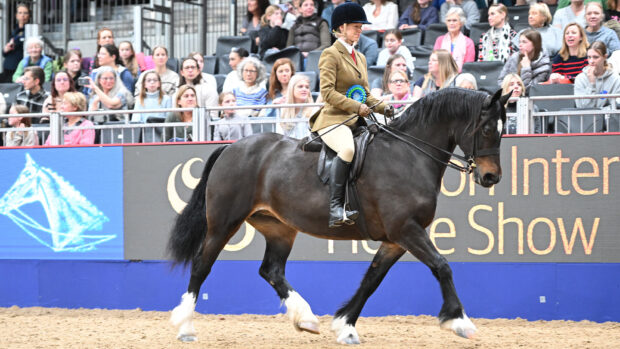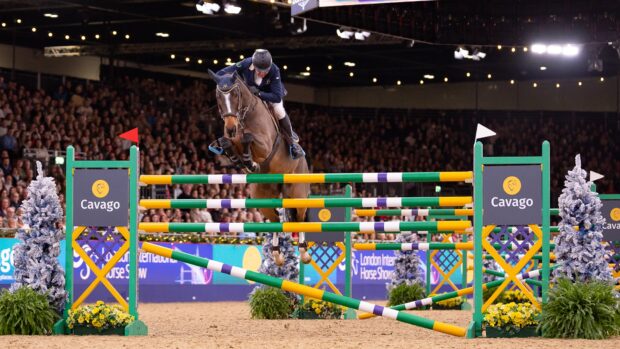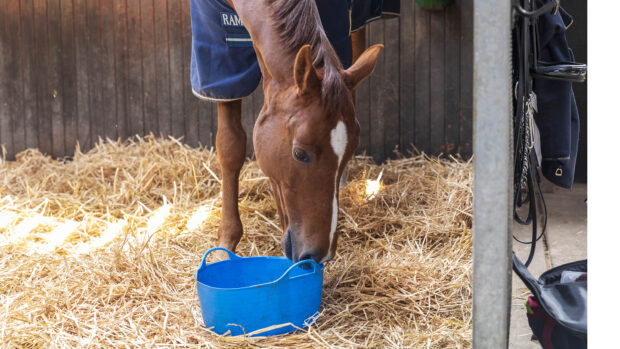Clicker training for horses is based on positive reinforcement. It is adding something the horse likes (usually food or scratches) after a behaviour, which makes that behaviour more likely to happen again.
The desired behaviour is marked with a click, also known as a “bridge signal”, which bridges the gap between click and reward. This means the horse knows reinforcement will follow hearing the click. Timing and correct use of food is crucial to success, and to avoid unwanted behaviours.
Lucy Chester, of Lucy Chester Horsemanship, says all horses can benefit, from days-old foals learning the very basics to adults learning advanced liberty and ridden work.
Setting horses up for clicker training success
There are several things you can do to help get your clicker training off on the right foot.
{"content":"PHA+4oCcTWFraW5nIHN1cmUgdGhlIGhvcnNlIGhhcyBhIGZ1bGwgc3RvbWFjaCBiZWZvcmUgdHJhaW5pbmcgaXMgaW1wb3J0YW50LOKAnSBMdWN5IHNheXMuIOKAnEkgYWx3YXlzIG1ha2Ugc3VyZSB0aGF0IG1pbmUgaGFzIGhhZCBhIGhheW5ldCBhbmQgYSBiaXQgb2YgaGFyZCBmZWVkLuKAnTwvcD4KPHA+PGRpdiBjbGFzcz0iYWQtY29udGFpbmVyIGFkLWNvbnRhaW5lci0tbW9iaWxlIj48ZGl2IGlkPSJwb3N0LWlubGluZS0yIiBjbGFzcz0iaXBjLWFkdmVydCI+PC9kaXY+PC9kaXY+PHNlY3Rpb24gaWQ9ImVtYmVkX2NvZGUtMzEiIGNsYXNzPSJoaWRkZW4tbWQgaGlkZGVuLWxnIHMtY29udGFpbmVyIHN0aWNreS1hbmNob3IgaGlkZS13aWRnZXQtdGl0bGUgd2lkZ2V0X2VtYmVkX2NvZGUgcHJlbWl1bV9pbmxpbmVfMiI+PHNlY3Rpb24gY2xhc3M9InMtY29udGFpbmVyIGxpc3RpbmctLXNpbmdsZSBsaXN0aW5nLS1zaW5nbGUtc2hhcmV0aHJvdWdoIGltYWdlLWFzcGVjdC1sYW5kc2NhcGUgZGVmYXVsdCBzaGFyZXRocm91Z2gtYWQgc2hhcmV0aHJvdWdoLWFkLWhpZGRlbiI+DQogIDxkaXYgY2xhc3M9InMtY29udGFpbmVyX19pbm5lciI+DQogICAgPHVsPg0KICAgICAgPGxpIGlkPSJuYXRpdmUtY29udGVudC1tb2JpbGUiIGNsYXNzPSJsaXN0aW5nLWl0ZW0iPg0KICAgICAgPC9saT4NCiAgICA8L3VsPg0KICA8L2Rpdj4NCjwvc2VjdGlvbj48L3NlY3Rpb24+PC9wPgo8cD5MdWN54oCZcyBzZWNvbmQgcmVjb21tZW5kYXRpb24gaXMgdG8gdXNlIGFwcHJvcHJpYXRlIHJlaW5mb3JjZW1lbnQg4oCTIG5vdCBhbGwgdHJlYXRzIGhhdmUgdGhlIGRlc2lyZWQgZWZmZWN0LjwvcD4KPHA+4oCcSSBnZW5lcmFsbHkgcmVjb21tZW5kIHNvbWV0aGluZyBvZiB2ZXJ5IGxvdyB2YWx1ZSB0byBob3JzZXMgbGlrZSBUaHVuZGVyYnJvb2vigJlzIEhheUNvYnMgb3IgU2ltcGxlIFN5c3RlbXPigJkgSGF5Q2FyZSzigJ0gc2hlIGFkdmlzZXMuIOKAnFByZXNzZWQgaGF5IG9yIG1lYWRvdyBncmFzcywgb3IgZXZlbiBjaGFmZiwgd2hpY2ggaGFzIGEgbG9uZ2VyIGNoZXcgdGltZSwgd2lsbCBsb3dlciBhcm91c2FsIGFyb3VuZCBmb29kLjwvcD4KPHA+4oCcWW91IHdhbnQgc29tZXRoaW5nIHRoYXQgZG9lc27igJl0IHNtZWxsIHN0cm9uZ2x5IGFzIGhvcnNlcyBoYXZlIGEgZ29vZCBzZW5zZSBvZiBzbWVsbCBhbmQgYXMgZm9yYWdpbmcgYW5pbWFscywgdGhleSB3aWxsIHRyeSB0byBmaW5kIGl0LiBUaGlzIG1ha2VzIHRyYWluaW5nIGhhcmRlciBhbmQgY2FuIHJlc3VsdCBpbiB1bmRlc2lyYWJsZSBiZWhhdmlvdXJzIHN1Y2ggYXMg4oCYbXVnZ2luZ+KAmS7igJ08L3A+CjxkaXYgY2xhc3M9ImFkLWNvbnRhaW5lciBhZC1jb250YWluZXItLW1vYmlsZSI+PGRpdiBpZD0icG9zdC1pbmxpbmUtMyIgY2xhc3M9ImlwYy1hZHZlcnQiPjwvZGl2PjwvZGl2Pgo8cD5UaGUgdGltZSBvZiBkYXkgaXMgYW5vdGhlciBrZXkgZmFjdG9yLjwvcD4KPHA+4oCcSWYgeW91ciBob3JzZSBpcyBkZXNwZXJhdGUgdG8gZ28gb3V0IGluIHRoZSBmaWVsZCwgaXQgbWlnaHQgbm90IGJlIHRoZSBiZXN0IHRpbWUgdG8gYmUgdHJhaW5pbmcs4oCdIHNoZSBzYXlzLiDigJxJIG1hZGUgdGhlIG1pc3Rha2Ugb25jZSBvZiB0cnlpbmcgdG8gdHJhaW4gbXkgaG9yc2UgZHVyaW5nIGhpcyBuYXAgdGltZS4gSGUgYWx3YXlzIGhhcyBhIHNsZWVwIGFib3V0IDExIG\/igJljbG9jaywgYW5kIHRoYXQgd2FzIG5ldmVyIGdvaW5nIHRvIHdvcmsuPC9wPgo8cD48ZGl2IGNsYXNzPSJhZC1jb250YWluZXIgYWQtY29udGFpbmVyLS1tb2JpbGUiPjxkaXYgaWQ9InBvc3QtaW5saW5lLTQiIGNsYXNzPSJpcGMtYWR2ZXJ0Ij48L2Rpdj48L2Rpdj48YnIgLz4KPGRpdiBpZD0iYXR0YWNobWVudF84OTM1ODkiIHN0eWxlPSJ3aWR0aDogMTQxMHB4IiBjbGFzcz0id3AtY2FwdGlvbiBhbGlnbm5vbmUiPjxpbWcgZmV0Y2hwcmlvcml0eT0iaGlnaCIgZGVjb2Rpbmc9ImFzeW5jIiBhcmlhLWRlc2NyaWJlZGJ5PSJjYXB0aW9uLWF0dGFjaG1lbnQtODkzNTg5IiBjbGFzcz0ibGF6eWxvYWQgYmx1ci11cCBzaXplLWZ1bGwgd3AtaW1hZ2UtODkzNTg5IiBkYXRhLXByb2Nlc3NlZCBzcmM9Imh0dHBzOi8va2V5YXNzZXRzLnRpbWVpbmN1ay5uZXQvaW5zcGlyZXdwL2xpdmUvd3AtY29udGVudC91cGxvYWRzL3NpdGVzLzE0LzIwMTcvMDMvbmV3LWhoLXBsYWNlaG9sZGVyLTIwMHgyMDAucG5nIiBkYXRhLXNyYz0iaHR0cHM6Ly9rZXlhc3NldHMudGltZWluY3VrLm5ldC9pbnNwaXJld3AvbGl2ZS93cC1jb250ZW50L3VwbG9hZHMvc2l0ZXMvMTQvMjAyNS8wNS9UQjNEREYuanBnIiBhbHQ9IkhvcnNlIHNsZWVwaW5nIGluIHN0YWJsZSIgd2lkdGg9IjE0MDAiIGhlaWdodD0iNzg4IiBkYXRhLXNpemVzPSJhdXRvIiBkYXRhLXNyY3NldD0iaHR0cHM6Ly9rZXlhc3NldHMudGltZWluY3VrLm5ldC9pbnNwaXJld3AvbGl2ZS93cC1jb250ZW50L3VwbG9hZHMvc2l0ZXMvMTQvMjAyNS8wNS9UQjNEREYuanBnIDE0MDB3LCBodHRwczovL2tleWFzc2V0cy50aW1laW5jdWsubmV0L2luc3BpcmV3cC9saXZlL3dwLWNvbnRlbnQvdXBsb2Fkcy9zaXRlcy8xNC8yMDI1LzA1L1RCM0RERi0zMDB4MTY5LmpwZyAzMDB3LCBodHRwczovL2tleWFzc2V0cy50aW1laW5jdWsubmV0L2luc3BpcmV3cC9saXZlL3dwLWNvbnRlbnQvdXBsb2Fkcy9zaXRlcy8xNC8yMDI1LzA1L1RCM0RERi02MzB4MzU1LmpwZyA2MzB3LCBodHRwczovL2tleWFzc2V0cy50aW1laW5jdWsubmV0L2luc3BpcmV3cC9saXZlL3dwLWNvbnRlbnQvdXBsb2Fkcy9zaXRlcy8xNC8yMDI1LzA1L1RCM0RERi0xMzV4NzYuanBnIDEzNXcsIGh0dHBzOi8va2V5YXNzZXRzLnRpbWVpbmN1ay5uZXQvaW5zcGlyZXdwL2xpdmUvd3AtY29udGVudC91cGxvYWRzL3NpdGVzLzE0LzIwMjUvMDUvVEIzRERGLTMyMHgxODAuanBnIDMyMHcsIGh0dHBzOi8va2V5YXNzZXRzLnRpbWVpbmN1ay5uZXQvaW5zcGlyZXdwL2xpdmUvd3AtY29udGVudC91cGxvYWRzL3NpdGVzLzE0LzIwMjUvMDUvVEIzRERGLTYyMHgzNDkuanBnIDYyMHcsIGh0dHBzOi8va2V5YXNzZXRzLnRpbWVpbmN1ay5uZXQvaW5zcGlyZXdwL2xpdmUvd3AtY29udGVudC91cGxvYWRzL3NpdGVzLzE0LzIwMjUvMDUvVEIzRERGLTkyMHg1MTguanBnIDkyMHcsIGh0dHBzOi8va2V5YXNzZXRzLnRpbWVpbmN1ay5uZXQvaW5zcGlyZXdwL2xpdmUvd3AtY29udGVudC91cGxvYWRzL3NpdGVzLzE0LzIwMjUvMDUvVEIzRERGLTEyMjB4Njg3LmpwZyAxMjIwdyIgc2l6ZXM9IihtYXgtd2lkdGg6IDE0MDBweCkgMTAwdncsIDE0MDBweCIgLz48cCBpZD0iY2FwdGlvbi1hdHRhY2htZW50LTg5MzU4OSIgY2xhc3M9IndwLWNhcHRpb24tdGV4dCI+UGljayB5b3VyIG1vbWVudDogeW91ciBob3JzZSBtaWdodCBiZSBsZXNzIGNvbmR1Y2l2ZSB0byBsZWFybmluZyBuZXcgdGhpbmdzIHdoZW4gaXTigJlzIG5hcCB0aW1lLiBDcmVkaXQ6IEFsYW15PC9wPjwvZGl2PjwvcD4KPHA+4oCcTW9zcXVpdG9lcyBhbmQgbWlkZ2VzIGFyZSBtb3JlIGxpa2VseSB0byBiZSBhcm91bmQgaW4gdGhlIGV2ZW5pbmdzIGFuZCB0aGUgaG9yc2UgY291bGQgZ2V0IGFubm95ZWQgYnkgdGhlbSwgd2hpY2ggd291bGQgaGF2ZSBhbiBpbXBhY3Qgb24gdHJhaW5pbmcs4oCdIEx1Y3kgYWR2aXNlcy4g4oCcSXTigJlzIGFib3V0IGtub3dpbmcgeW91ciBob3JzZSBhbmQgZXhwZXJpbWVudGluZyB0byBmaW5kIG91dCB3aGF0IHN1aXRzIGVhY2ggb25lIGJlc3Qu4oCdPC9wPgo8ZGl2IGNsYXNzPSJhZC1jb250YWluZXIgYWQtY29udGFpbmVyLS1tb2JpbGUiPjxkaXYgaWQ9InBvc3QtaW5saW5lLTUiIGNsYXNzPSJpcGMtYWR2ZXJ0Ij48L2Rpdj48L2Rpdj4KPHA+QW5vdGhlciBhc3BlY3QgdG8gY29uc2lkZXIgdG8gZ2V0IHRoZSBtb3N0IG91dCBvZiB5b3VyIHRyYWluaW5nIHNlc3Npb24gaXMgeW91ciB3b3JraW5nIGVudmlyb25tZW50LjwvcD4KPHA+4oCcSWYgc29tZW9uZSBoYXMganVzdCBzdGFydGVkIHRyaW1taW5nIHRoZSBoZWRnZSBieSB0aGUgYXJlbmEsIGl04oCZcyBwcm9iYWJseSBub3QgYW4gaWRlYWwgdGltZSB0byBzdGFydCzigJ0gTHVjeSBjYXV0aW9ucy4g4oCcQSBsb3Qgb2YgcGVvcGxlIGFyZSBpbiBsaXZlcnkgeWFyZHMgdGhhdCBhcmUgcmVhbGx5IGJ1c3ksIHNvIGl04oCZcyBtdWNoIGJldHRlciB0byB0cnkgdG8gZG8gaXQgd2hlbiBpdOKAmXMgcXVpZXQuIFRoZW4geW91IGNhbiBmb2N1cyAxMDAlIG9uIHRoZSBob3JzZS48L3A+CjxwPuKAnEhvcnNlcyBsb3ZlIHBvc2l0aXZlIHJlaW5mb3JjZW1lbnQgdHJhaW5pbmcgYW5kIGlmIHlvdeKAmXJlIGJ1c3kgdGFsa2luZyB0byBzb21lb25lIGVsc2UsIHRoZSBob3JzZSBpcyBnb2luZyB0byBiZSBudWRnaW5nIHlvdSBmb3IgdGhlIGZvb2QsIGJlY2F1c2UgeW914oCZcmUgbm90IGZvY3VzZWQgb24gdGhlbSwgYW5kIGl04oCZcyBub3QgZmFpci4gSSBmaW5kIHBlb3BsZSBhcmUgcmVhbGx5IGludGVyZXN0ZWQgaW4gd2hhdCBJ4oCZbSBkb2luZywgd2hpY2ggaXMgZ3JlYXQsIGJ1dCBpdCBtZWFucyB5b3XigJlyZSBkaXN0cmFjdGVkIGZyb20geW91ciBob3JzZSBhbmQgdGhlIHRyYWluaW5nLiBTbyBpZiBwZW9wbGUgYXJlIGludGVyZXN0ZWQsIGFzayB0aGVtIHRvIHRhbGsgdG8geW91IGFib3V0IGl0IGFmdGVyd2FyZHMu4oCdPC9wPgo8cD5MaWtld2lzZSwgaWYgdGhlcmUgaXMgYW5vdGhlciBob3JzZSBpbiB0aGUgYXJlbmEsIGJlY2F1c2UgeW91IGFyZSB1c2luZyBmb29kLCB0aGVyZSBjYW4gYmUgYW4gaXNzdWUgd2l0aCByZXNvdXJjZSBndWFyZGluZywgc28gTHVjeSBwcmVmZXJzIHRvIHRyYWluIG9uIGhlciBvd24uPC9wPgo8aDM+SG93IHRvIGxlYXJuIHRoZSBjb3JyZWN0IHRlY2huaXF1ZXM8L2gzPgo8cD5Eb27igJl0IGV4cGVjdCB0byBiZSBhYmxlIHRvIG5haWwgY2xpY2tlciB0cmFpbmluZyBieSB5b3Vyc2VsZiwgc3RyYWlnaHQgb2ZmLiBMdWN5IHNheXMgdGhhdCBvZiBhbGwgdGhlIHdheXMgc2hlIGhhcyB0cmllZCB0cmFpbmluZyBob3JzZXMsIGNsaWNrZXIgdHJhaW5pbmcgaGFzIGJlZW4gdGhlIOKAnGhhcmRlc3QgdG8gZG8gd2VsbCDigJMgaW4gdGhlIGJlZ2lubmluZ+KAnS48L3A+CjxwPuKAnEl04oCZcyBpbXBvcnRhbnQgYXQgbGVhc3QgdG8gc3RhcnQgd2l0aCBhIHByb2Zlc3Npb25hbCB0byBndWlkZSB5b3U7IHRpbWluZyBvZiBjbGlja2luZyBhbmQgcmV3YXJkaW5nIGlzIGtleSwgYW5kIGFsbCB0aGVzZSB0aGluZ3Mgd2lsbCBoYXZlIGFuIGltcGFjdCBvbiB0aGUgc3VjY2VzcyBvZiB0cmFpbmluZyzigJ0gc2hlIHNheXMuPC9wPgo8cD7igJxGb29kIGlzIGhpZ2hseSBtb3RpdmF0aW5nIHRvIGhvcnNlcywgYW5kIG9uY2UgeW914oCZdmUgZ290IGEgc29saWQgZm91bmRhdGlvbiwgZXZlcnl0aGluZyBlbHNlIGJlY29tZXMgZWFzeS7igJ08L3A+CjxkaXYgaWQ9ImF0dGFjaG1lbnRfODkzNTkzIiBzdHlsZT0id2lkdGg6IDE0MTBweCIgY2xhc3M9IndwLWNhcHRpb24gYWxpZ25ub25lIj48aW1nIGRlY29kaW5nPSJhc3luYyIgYXJpYS1kZXNjcmliZWRieT0iY2FwdGlvbi1hdHRhY2htZW50LTg5MzU5MyIgY2xhc3M9Imxhenlsb2FkIGJsdXItdXAgc2l6ZS1mdWxsIHdwLWltYWdlLTg5MzU5MyIgZGF0YS1wcm9jZXNzZWQgc3JjPSJodHRwczovL2tleWFzc2V0cy50aW1laW5jdWsubmV0L2luc3BpcmV3cC9saXZlL3dwLWNvbnRlbnQvdXBsb2Fkcy9zaXRlcy8xNC8yMDE3LzAzL25ldy1oaC1wbGFjZWhvbGRlci0yMDB4MjAwLnBuZyIgZGF0YS1zcmM9Imh0dHBzOi8va2V5YXNzZXRzLnRpbWVpbmN1ay5uZXQvaW5zcGlyZXdwL2xpdmUvd3AtY29udGVudC91cGxvYWRzL3NpdGVzLzE0LzIwMjUvMDUvMkMxNE5ZMC5qcGciIGFsdD0iSG9yc2UgbG9va2luZyBncnVtcHkgdHJ5aW5nIHRvIGVhdCBjYXJyb3RzIiB3aWR0aD0iMTQwMCIgaGVpZ2h0PSI4MDYiIGRhdGEtc2l6ZXM9ImF1dG8iIGRhdGEtc3Jjc2V0PSJodHRwczovL2tleWFzc2V0cy50aW1laW5jdWsubmV0L2luc3BpcmV3cC9saXZlL3dwLWNvbnRlbnQvdXBsb2Fkcy9zaXRlcy8xNC8yMDI1LzA1LzJDMTROWTAuanBnIDE0MDB3LCBodHRwczovL2tleWFzc2V0cy50aW1laW5jdWsubmV0L2luc3BpcmV3cC9saXZlL3dwLWNvbnRlbnQvdXBsb2Fkcy9zaXRlcy8xNC8yMDI1LzA1LzJDMTROWTAtMzAweDE3My5qcGcgMzAwdywgaHR0cHM6Ly9rZXlhc3NldHMudGltZWluY3VrLm5ldC9pbnNwaXJld3AvbGl2ZS93cC1jb250ZW50L3VwbG9hZHMvc2l0ZXMvMTQvMjAyNS8wNS8yQzE0TlkwLTYzMHgzNjMuanBnIDYzMHcsIGh0dHBzOi8va2V5YXNzZXRzLnRpbWVpbmN1ay5uZXQvaW5zcGlyZXdwL2xpdmUvd3AtY29udGVudC91cGxvYWRzL3NpdGVzLzE0LzIwMjUvMDUvMkMxNE5ZMC0xMzV4NzguanBnIDEzNXcsIGh0dHBzOi8va2V5YXNzZXRzLnRpbWVpbmN1ay5uZXQvaW5zcGlyZXdwL2xpdmUvd3AtY29udGVudC91cGxvYWRzL3NpdGVzLzE0LzIwMjUvMDUvMkMxNE5ZMC0zMjB4MTg0LmpwZyAzMjB3LCBodHRwczovL2tleWFzc2V0cy50aW1laW5jdWsubmV0L2luc3BpcmV3cC9saXZlL3dwLWNvbnRlbnQvdXBsb2Fkcy9zaXRlcy8xNC8yMDI1LzA1LzJDMTROWTAtNjIweDM1Ny5qcGcgNjIwdywgaHR0cHM6Ly9rZXlhc3NldHMudGltZWluY3VrLm5ldC9pbnNwaXJld3AvbGl2ZS93cC1jb250ZW50L3VwbG9hZHMvc2l0ZXMvMTQvMjAyNS8wNS8yQzE0TlkwLTkyMHg1MzAuanBnIDkyMHcsIGh0dHBzOi8va2V5YXNzZXRzLnRpbWVpbmN1ay5uZXQvaW5zcGlyZXdwL2xpdmUvd3AtY29udGVudC91cGxvYWRzL3NpdGVzLzE0LzIwMjUvMDUvMkMxNE5ZMC0xMjIweDcwMi5qcGcgMTIyMHciIHNpemVzPSIobWF4LXdpZHRoOiAxNDAwcHgpIDEwMHZ3LCAxNDAwcHgiIC8+PHAgaWQ9ImNhcHRpb24tYXR0YWNobWVudC04OTM1OTMiIGNsYXNzPSJ3cC1jYXB0aW9uLXRleHQiPkNob29zZSBhcHByb3ByaWF0ZSB0cmVhdHM6IGNhcnJvdHMgYXJlIHRvbyBoaWdoLXZhbHVlIGFuZCBtYXkgZW5jb3VyYWdlIHRoZSBob3JzZSB0byBzbmF0Y2ggYXQgdGhlbS4gQ3JlZGl0OiBBbGFteTwvcD48L2Rpdj4KPGgyPkhvdyB0byBhdm9pZCBtaXN0YWtlcyBpbiBjbGlja2VyIHRyYWluaW5nIGZvciBob3JzZXM8L2gyPgo8cD5MdWN5IG91dGxpbmVzIGhvdyB0byB1c2UgdGhlIHRyZWF0cyBjb3JyZWN0bHkuPC9wPgo8cD7igJxQZW9wbGUgdGhpbmsgaG9yc2VzIGNhbiBnZXQgcHVzaHkgb3IgYmFyZ3kgYmVjYXVzZSBvZiB0aGUgZm9vZCBidXQgYXMgd2VsbCBhcyB1c2luZyBhcHByb3ByaWF0ZSB0cmVhdHMsIGFzIGFib3ZlLCBpdCBhbGwgY29tZXMgZG93biB0byB0aW1pbmcs4oCdIHNoZSBzYXlzLiDigJxJZiB0aGUgaG9yc2UgY29tZXMgdG8gc25pZmYgeW91ciBwb2NrZXQgYW5kIHlvdSBqdXN0IGdpdmUgdGhlbSBhIHRyZWF0LCB5b3XigJlyZSByZWluZm9yY2luZyB0aGF0IGNvbWluZyB0byB5b3VyIHBvY2tldCBnZXRzIHRoZSB0cmVhdC48L3A+CjxwPuKAnEl04oCZcyB2ZXJ5IGVhc3kgdG8gbWFrZSBzaW1wbGUgbWlzdGFrZXMgbGlrZSB0aGF0LCBvciB0byBjbGljayBhdCBhIG1vbWVudCB3aGVyZSB0aGV54oCZcmUgY29taW5nIGJhY2sgdG93YXJkcyB5b3VyIGhhbmQgb3IgdG93YXJkcyB5b3VyIHBvY2tldC4gSSB0ZW5kIHRvIHVzZSBhIGJvd2wgb2YgY2hhZmYgb3Igc29tZXRoaW5nIHdpdGggYSBsb25nZXIgY2hldyB0aW1lLCBhbmQgSSByZXdhcmQgY29uc3RhbnRseSBmb3IgYmVpbmcgaW4gYSBjZXJ0YWluIHBvc2l0aW9uLiBTbyB5b3XigJlyZSB0cmFpbmluZyB0aGVtIHdoZXJlIHlvdSB3YW50IHRoZW0gdG8gYmUgd2hlbiB5b3UgZGVsaXZlciB0aGUgcmVpbmZvcmNlbWVudC48L3A+CjxwPuKAnFlvdSBwdXQgZm9vZCBpbiB0aGUgYm93bC4gVGhleSBlYXQgaXQuIFlvdSBjbGljayBhbmQgdGhlbiB5b3UgcHV0IG1vcmUgZm9vZCBpbiB0aGUgYm93bCBiZWZvcmUgdGhleSBmaW5pc2ggZWF0aW5nLiBZb3XigJlyZSB0ZWFjaGluZyB0aGVtIHRoYXQgYWZ0ZXIgdGhlIGNsaWNrLCBmb29kIGNvbWVzLCBhbmQgdGhleSBkb27igJl0IG5lZWQgdG8gc3RyZXNzIGFib3V0IGl0LiBUaGVuIHlvdSBjYW4gZG8gdGhlIHNhbWUgdGhpbmcgc3RhbmRpbmcgbmV4dCB0byB0aGVtLCBiZWNhdXNlIHRoZXnigJl2ZSBhbHJlYWR5IHVuZGVyc3Rvb2QgdGhhdCB5b3UgYnJpbmcgdGhlIGZvb2QgdG8gdGhlbSwgdGhleSBkb27igJl0IGNvbWUgdG8geW91IGZvciB0aGUgZm9vZC7igJ08L3A+CjxwPkJ1dCBldmVuIHdoZW4geW914oCZcmUgZG9pbmcgZXZlcnl0aGluZyByaWdodCwgc29tZSBob3JzZXMgY2FuIHN0aWxsIGJlIHNuYXRjaHkuPC9wPgo8cD7igJxGb3IgbWUsIHRoaXMgaGlnaGxpZ2h0cyB0aGF0IGV2ZXJ5dGhpbmcgaXNu4oCZdCBPSyzigJ0gd2FybnMgTHVjeS4g4oCcSWYgYSBob3JzZSBpcyBpbiBwYWluLCB0aGVpciDigJhzdHJlc3MgamFy4oCZIGlzIGZhaXJseSBmdWxsIHNvIGl0IGRvZXNu4oCZdCB0YWtlIG11Y2ggdG8gdGlwIHRoZW0gb3Zlci7igJ08L3A+CjxoMz5DaGFuZ2luZyB0aW1lcyBmb3IgaG9yc2UgdHJhaW5pbmc8L2gzPgo8cD5MdWN5IGhhcyBub3RpY2VkIGEgc2hpZnQgaW4gYXR0aXR1ZGVzIHRvd2FyZHMgaG9yc2UgYmVoYXZpb3VyLCBidXQgYmVsaWV2ZXMgdGhlcmUgaXMgc3RpbGwgc29tZSB3YXkgdG8gZ28uPC9wPgo8cD7igJxJIHRoaW5rIHRoaW5ncyBhcmUgY2hhbmdpbmcgYnV0IEkgc2F3IHJlY2VudGx5LCBmb3IgZXhhbXBsZSwgc29tZW9uZSBoYWQgcG9zdGVkIG9uIGEgYmVoYXZpb3VyIHBhZ2UgYSBob3JzZSBzaG93aW5nIHByZXR0eSBleHRyZW1lIGRpc2NvbWZvcnQ7IHRhaWwgc3dpc2hpbmcsIGhlYWQgdG9zc2luZywgZWFycyBwaW5uZWQgYmFjayzigJ0gc2hlIHNheXMuIOKAnFByb2JhYmx5IDYwJSBvZiBwZW9wbGUgc2FpZCBwYWluLCB0YWxrIHRvIHRoZSB2ZXQsIGJ1dCA0MCUgc2FpZCwg4oCYWW91IG5lZWQgYSBiZXR0ZXIgdHJhaW5lciwgc2VsbCB0aGUgaG9yc2UsIGl04oCZcyBiZWluZyBuYXVnaHR54oCZLiBJIHRob3VnaHQsIOKAmFBvb3IgaG9yc2UsIHdoeSBhcmVu4oCZdCB5b3UgbGlzdGVuaW5nP+KAmeKAnTwvcD4KPHA+THVjeSBsaXN0cyByZXNlYXJjaCBwYXBlcnMgdG8gYmFjayB1cCB0aGUgc3lzdGVtIHdpdGggc2NpZW5jZS48L3A+CjxwPuKAnElmIHBlb3BsZSBhcmUgc2NlcHRpY2FsLCB0aGVyZSBhcmUgbnVtZXJvdXMgc3R1ZGllcyB0byBiYWNrIHVwIHRoZSBlZmZlY3RpdmVuZXNzIG9mIHBvc2l0aXZlIHJlaW5mb3JjZW1lbnQgYXMgYSB3YXkgdG8gdHJhaW4gaG9yc2VzLOKAnSBzaGUgZXhwbGFpbnMsIGxpc3RpbmcgPGEgaHJlZj0iaHR0cHM6Ly93d3cuc2NpZW5jZWRpcmVjdC5jb20vc2NpZW5jZS9hcnRpY2xlL3BpaS9TMDE2ODE1OTEyMjAwMTA5NSI+TGFyc3NlbiAmYW1wOyBSb3RoLCAyMDIyPC9hPiwgPGEgaHJlZj0iaHR0cHM6Ly9wdWJtZWQubmNiaS5ubG0ubmloLmdvdi8yMDQ5MDU5Mi8iPlNhbmtleSBldCBhbCwgMjAxMDwvYT4sIDxhIGhyZWY9Imh0dHBzOi8vcHVibWVkLm5jYmkubmxtLm5paC5nb3YvMzYzNTkwMzEvIj5DYXJyb2xsLCBTeWtlcyAmYW1wOyBNaWxscywgMjAyMjwvYT4uPC9wPgo8ZGl2IGNsYXNzPSJpbmplY3Rpb24iPjwvZGl2Pgo8cD7igJxBbmQgdGhlcmUgYXJlIG1hbnkgdHJhaW5lcnMgbGlrZSBtZSB3aG8gYXJlIHByb29mIGl0IHdvcmtzLCBmb3IgYWxsIGhvcnNlcyBmcm9tIHR3by13ZWVrLW9sZCBmb2FscyB0byBzdGFsbGlvbnMgYW5kIGV2ZXJ5dGhpbmcgaW4gYmV0d2VlbizigJ0gc2hlIGNvbmNsdWRlcy48L3A+CjxkaXYgaWQ9ImF0dGFjaG1lbnRfODkzNTk4IiBzdHlsZT0id2lkdGg6IDE0MTBweCIgY2xhc3M9IndwLWNhcHRpb24gYWxpZ25ub25lIj48aW1nIGRlY29kaW5nPSJhc3luYyIgYXJpYS1kZXNjcmliZWRieT0iY2FwdGlvbi1hdHRhY2htZW50LTg5MzU5OCIgY2xhc3M9Imxhenlsb2FkIGJsdXItdXAgc2l6ZS1mdWxsIHdwLWltYWdlLTg5MzU5OCIgZGF0YS1wcm9jZXNzZWQgc3JjPSJodHRwczovL2tleWFzc2V0cy50aW1laW5jdWsubmV0L2luc3BpcmV3cC9saXZlL3dwLWNvbnRlbnQvdXBsb2Fkcy9zaXRlcy8xNC8yMDE3LzAzL25ldy1oaC1wbGFjZWhvbGRlci0yMDB4MjAwLnBuZyIgZGF0YS1zcmM9Imh0dHBzOi8va2V5YXNzZXRzLnRpbWVpbmN1ay5uZXQvaW5zcGlyZXdwL2xpdmUvd3AtY29udGVudC91cGxvYWRzL3NpdGVzLzE0LzIwMjUvMDUvMkRNOEdCRS5qcGciIGFsdD0iQ2hlc3RudXQgZm9hbCBoZWFkIHNob3QiIHdpZHRoPSIxNDAwIiBoZWlnaHQ9Ijc4OCIgZGF0YS1zaXplcz0iYXV0byIgZGF0YS1zcmNzZXQ9Imh0dHBzOi8va2V5YXNzZXRzLnRpbWVpbmN1ay5uZXQvaW5zcGlyZXdwL2xpdmUvd3AtY29udGVudC91cGxvYWRzL3NpdGVzLzE0LzIwMjUvMDUvMkRNOEdCRS5qcGcgMTQwMHcsIGh0dHBzOi8va2V5YXNzZXRzLnRpbWVpbmN1ay5uZXQvaW5zcGlyZXdwL2xpdmUvd3AtY29udGVudC91cGxvYWRzL3NpdGVzLzE0LzIwMjUvMDUvMkRNOEdCRS0zMDB4MTY5LmpwZyAzMDB3LCBodHRwczovL2tleWFzc2V0cy50aW1laW5jdWsubmV0L2luc3BpcmV3cC9saXZlL3dwLWNvbnRlbnQvdXBsb2Fkcy9zaXRlcy8xNC8yMDI1LzA1LzJETThHQkUtNjMweDM1NS5qcGcgNjMwdywgaHR0cHM6Ly9rZXlhc3NldHMudGltZWluY3VrLm5ldC9pbnNwaXJld3AvbGl2ZS93cC1jb250ZW50L3VwbG9hZHMvc2l0ZXMvMTQvMjAyNS8wNS8yRE04R0JFLTEzNXg3Ni5qcGcgMTM1dywgaHR0cHM6Ly9rZXlhc3NldHMudGltZWluY3VrLm5ldC9pbnNwaXJld3AvbGl2ZS93cC1jb250ZW50L3VwbG9hZHMvc2l0ZXMvMTQvMjAyNS8wNS8yRE04R0JFLTMyMHgxODAuanBnIDMyMHcsIGh0dHBzOi8va2V5YXNzZXRzLnRpbWVpbmN1ay5uZXQvaW5zcGlyZXdwL2xpdmUvd3AtY29udGVudC91cGxvYWRzL3NpdGVzLzE0LzIwMjUvMDUvMkRNOEdCRS02MjB4MzQ5LmpwZyA2MjB3LCBodHRwczovL2tleWFzc2V0cy50aW1laW5jdWsubmV0L2luc3BpcmV3cC9saXZlL3dwLWNvbnRlbnQvdXBsb2Fkcy9zaXRlcy8xNC8yMDI1LzA1LzJETThHQkUtOTIweDUxOC5qcGcgOTIwdywgaHR0cHM6Ly9rZXlhc3NldHMudGltZWluY3VrLm5ldC9pbnNwaXJld3AvbGl2ZS93cC1jb250ZW50L3VwbG9hZHMvc2l0ZXMvMTQvMjAyNS8wNS8yRE04R0JFLTEyMjB4Njg3LmpwZyAxMjIwdyIgc2l6ZXM9IihtYXgtd2lkdGg6IDE0MDBweCkgMTAwdncsIDE0MDBweCIgLz48cCBpZD0iY2FwdGlvbi1hdHRhY2htZW50LTg5MzU5OCIgY2xhc3M9IndwLWNhcHRpb24tdGV4dCI+TmV2ZXIgdG9vIHlvdW5nIHRvIHN0YXJ0OiBldmVuIHlvdW5nIGZvYWxzIGNhbiBiZW5lZml0IGZyb20gY2xpY2tlciB0cmFpbmluZy4gQ3JlZGl0OiBBbGFteTwvcD48L2Rpdj4KPHA+QXJlIHlvdSBrZWVuIHRvIHRyeSBjbGlja2VyIHRyYWluaW5nIGZvciBob3JzZXMgeW91cnNlbGY\/IENoZWNrIG91dCBMdWN54oCZcyBzdGFydGVyIGV4ZXJjaXNlcyBiZWxvdy48L3A+CjxwPgo="}
Did you enjoy this? You may also like to read…
Credit: Barry Chester
Credit: Alamy Stock Photo
H&H recommends wearing gloves while doing groundwork with horses.
Credit: Alamy Stock Photo
Understanding how horses learn can help to you to build a bond with your horse.
Credit: Alamy Stock Photo
Getting inside a horse’s mind is vital for training them effectively.
Credit: Emma Herrod Photography
Confidence and experience are essential for handling horses when they are fresh or spooky.
Credit: Philip Barker
Stay in touch with all the news in the run-up to and throughout the major shows and events during 2025 and beyond with a Horse & Hound subscription. Subscribe today for all you need to know ahead of these major events, plus online reports on the action as it happens from our expert team of reporters and in-depth analysis in our special commemorative magazines. Have a subscription already? Set up your unlimited website access now
H&H news editor
Eleanor is an experienced journalist who spent over eight years working for local and national newspapers before joining H&H as news editor in March 2016. Passionate about equine welfare and exposing the truth, Eleanor has reported on all aspects of the industry, from Brexit to anti-bullying campaigns, and from dressage rules to mules. Her sport of choice is showjumping, in which she competes her own horses, and she also enjoys reporting at local jumping shows through to international championships.










